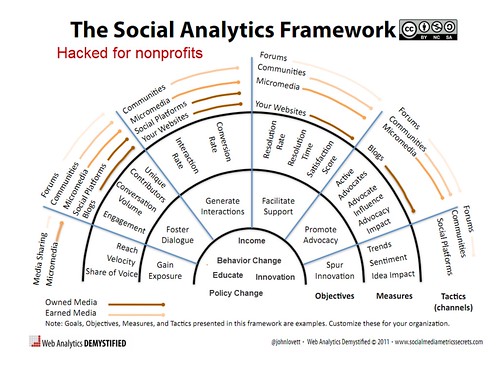I’ve been reading Social Media Metrics Secrets by John Lovett who is a senior partner at Web Analytics Demystified where Eric T. Peterson is the founder and senior partner. The book is wonderful and before I share some of what I learned I have to tell you a story.
I first encountered Eric after I created a screencast for NTEN called “Web Analytics Demystified for Nonprofits” and (wiki). He sent me an email. As soon as I saw the address, I thought it might be a cease and desist letter because he had trademarked the name. No, he thought that it was fantastic that we were educating the nonprofit sector about this important topic. Always community-minded, Eric has gone on to create the Analytics Exchange which pairs nonprofits with analytics volunteers from the private sector – a great way to provide education and support for nonprofits as they embrace measurement.

I’ve referred several Packard grantees who have used John Lovett’s social analytics framework to help them think through social media metrics. I sent a tweet to John asking if there was a blank copy and he sent me a blank one with permission to hack and share. I modified one of his corporate versions for nonprofits above.
And now on to the book. There were a couple of sections that really resonated, but I’m only going to focus on one for now.
One point that he keeps making over and over: Metrics must have meaning or else they’re just numbers. He also points out that need to know context – what your measuring towards and that there are different layers of metrics.
He suggests that social media managers need to become curator of metrics, not just collectors of data. It is what Shonali Burke is talking about when I asked her about the art and tradecraft of measurement. Here’s what that means.
- What you need to do: If you are doing social media for your organization, either part time or your whole job, you need to handle metrics. You need to define, manage, organize, explain and share them. You know if you’re doing a good job if this leads you to stories about success or failure and ultimately helps you learn how to get more impact with your social media efforts.
- Key Skills: A social media metrics curator knows the difference between metrics and numbers and ensures that her organization is using data in an intelligent way. Whenever they report on social media results, they present insights in a meaningful way, not raw undigested numbers. The information is also reported with a link to organizational results.
- The Metrics Layer Cake: There are hundred plus metrics you could use to measure social media, but a social media curator knows there are different layers or types of metrics. In Lovett’s book, describes these as:
Foundational: These are a handful of metrics that persist across all channels. These will be different depending on the nonprofit’s mission and programs, but are based on a theory of change or asking to what end? What will change? Momsrising calls these key result areas and uses them for every campaign they do. Given they are an advocacy group, their key results are different from say, the Smithsonian Archives which has a different set of foundational metrics.
Value Metrics: These are a handful of metrics that support over-arching goals. These might include social impact, behavior change, saved time, or income.
Outcome Metrics: These are metrics that take into account a specific objective for a campaign or program that your organization is working on. This might include: awareness, engagement, attitude change, encouraging interaction, facilitating support, promoting advocacy, or encouraging innovation. Lovett also refers to these as KPIs.
Counting Metrics: These are the lowest level of social media metrics – and as Lovett points out represents the minutia of social media metrics. This is fans, followers, visitors, and views. The list goes on and on. These are important to use to help you improve what you’re doing, but many times organizations get stuck in only tracking low-level metrics and often in an inconsistent way or without the discipline that Shonali talks about in the video.
If you’re doing a good job as a social media metrics curator, then when you present reports, you get better questions from your executive director. You don’t asked how many fans do we have or what does that mean? You get questions that help you improve what you’re doing and perhaps even more budget investment to accomplish it.
How are you curating your organization’s social media metrics?

Leave a Reply